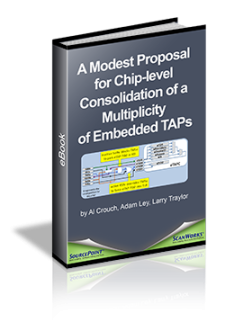Cores and other blocks of intellectual property (IP) often feature a test access port (TAP). When multiple such IP blocks are integrated into a system-on-a-chip (SoC), their TAPs become embedded. Such embedded TAPs (eTAP) are prone to conflict with each other, which can prevent engineers from accessing IP blocks during SoC debug, validation or test. A new eBook from ASSET InterTech explains how some up-front planning will avoid these problems.
“Unfortunately, having defined the TAP as the primary and only test access port on a chip, the IEEE 1149.1 JTAG standard doesn’t provide any guidance on the integration of eTAPs into an SoC,” said Adam Ley, one of the three authors of the eBook and ASSET’s chief technologist, non-intrusive board test and JTAG. “Without some forethought during design, accessing all of the eTAPs later with engineering tools could be difficult or even impossible. Useful guidance for integrating multiple eTAPs can be found in the IEEE 1687 IJTAG and IEEE 1149.7 standards, but having this information in two documents makes it more difficult to use. So, we’ve compiled the information engineers need most to get around this problem and remain compliant with all standards in our new eBook.”
Titled “A Modest Proposal for Chip-Level Consolidation of a Multiplicity of Embedded TAPs with Consideration for JTAG Boundary Scan, JTAG Software Debug, and IJTAG Instrumentation Networks,” the new eBook recommends several design best practices, which, if followed, will allow access to an SoC’s IP blocks. The eBook is free and available now on the ASSET web site in the eResources center .


